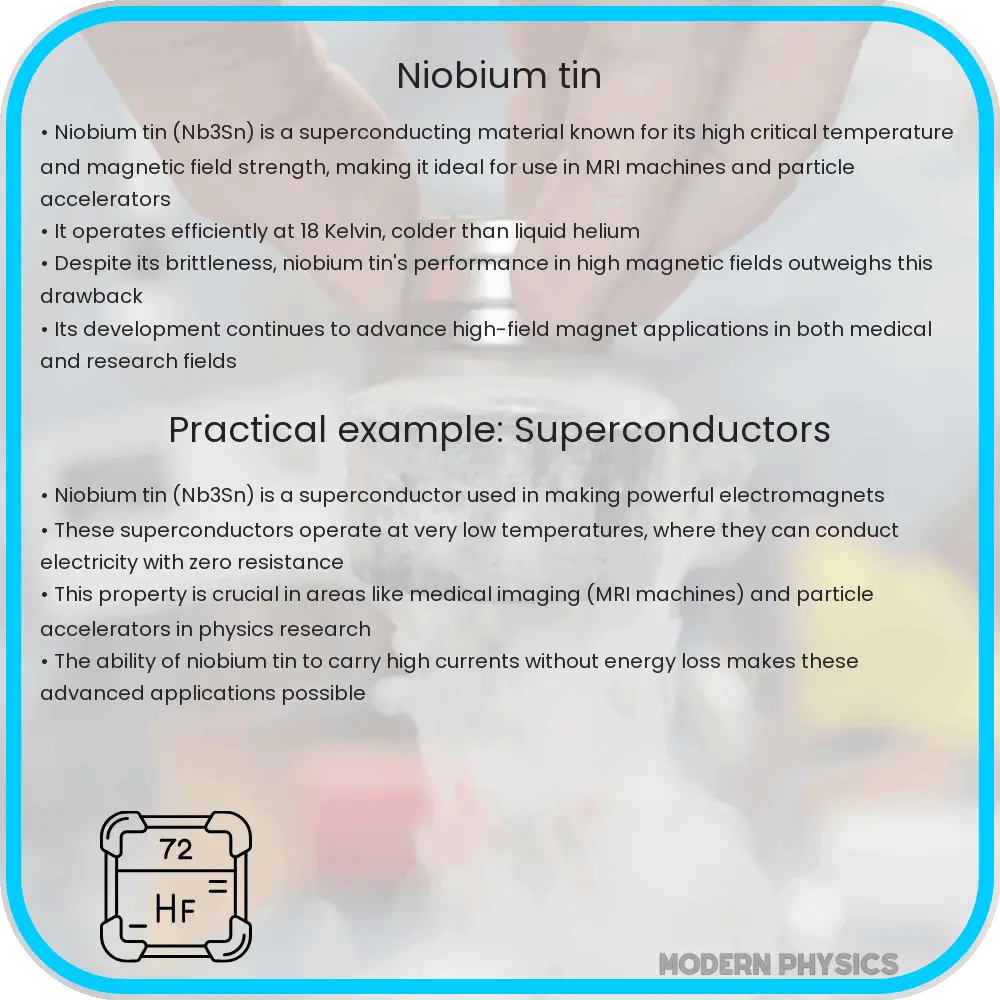Explore the superior properties and diverse applications of Niobium Tin (Nb3Sn), a leading superconductor enhancing efficiency and durability in technology.

Introduction to Niobium Tin: Advancing Technology
Niobium Tin (Nb3Sn) stands out in the realm of superconducting materials due to its exceptional high-performance characteristics, efficiency, and durability. This compound is critical in various advanced technological applications, ranging from magnetic resonance imaging (MRI) machines to particle accelerators and nuclear reactors. Its significance lies in its ability to conduct electricity with zero resistance at considerably higher temperatures and magnetic fields than many other superconductors.
Characteristics and Benefits of Niobium Tin
The allure of Nb3Sn is primarily due to its superior superconducting properties. Unlike traditional conductors, which lose energy through heat dissipation, Nb3Sn can carry electrical current without energy loss when cooled below its critical temperature, which is approximately 18 Kelvin (-255.15°C). This attribute makes it highly sought after for applications requiring efficient energy transmission.
- High Critical Field: Nb3Sn excels in maintaining superconductivity in high magnetic fields, surpassing the capabilities of many conventional superconductors. This makes it ideal for use in high-field magnets essential in scientific research and medical imaging.
- Enhanced Durability: In addition to its superconducting qualities, Nb3Sn is noted for its robustness and resistance to strain and wear, enhancing the longevity and reliability of devices that incorporate it.
- Efficiency: The efficiency of Nb3Sn in conducting electricity reduces energy losses significantly, leading to cost savings and environmental benefits in large-scale industrial and medical applications.
Despite these advantages, working with Nb3Sn presents challenges, such as its brittleness and complex manufacturing process. However, ongoing research and technological advancements aim to overcome these hurdles, broadening the scope of its applications.
Applications of Niobium Tin
Nb3Sn’s unique properties have paved the way for its use in a variety of cutting-edge technologies. In the medical field, it is a critical component in the coils of MRI machines, enabling clearer imaging and faster patient diagnosis. In the realm of physics and engineering, it is used in particle accelerators and fusion reactors, where its high critical magnetic fields are essential for pushing the boundaries of what is scientifically possible.
Challenges and Future Prospects
Despite its many advantages, the deployment of Niobium Tin is not without challenges. The material’s inherent brittleness and sensitivity to strain can lead to complications during the manufacturing process, potentially affecting the performance and reliability of superconducting magnets and other devices. Additionally, the production of Nb3Sn requires a high-temperature reaction process, which can be both time-consuming and costly.
However, the future looks promising for Nb3Sn, as ongoing research focuses on overcoming these obstacles. Innovations in material processing and alloy composition are making it more feasible and cost-effective to produce, thereby extending its potential applications. Furthermore, as the demand for more efficient and powerful superconducting materials continues to grow, particularly in renewable energy and advanced transportation systems, Nb3Sn is poised to play a pivotal role.
Environmental Impact and Sustainability
The environmental implications of using Nb3Sn are also noteworthy. By enabling more efficient electrical systems, it contributes to reducing energy wastage and carbon emissions, aligning with global sustainability goals. Moreover, as the material aids in the development of cleaner energy technologies like fusion power, its environmental benefits are expected to expand even further.
Conclusion
Niobium Tin (Nb3Sn) represents a cornerstone in the field of superconducting materials, offering unmatched efficiency, durability, and performance under extreme conditions. Despite facing manufacturing and handling challenges, its role in advancing medical imaging, scientific research, and clean energy technologies is undeniable. As research continues to address its limitations, the future of Nb3Sn is bright, heralding a new era of technological innovation and environmental stewardship. With its potential still unfolding, Niobium Tin remains a key player in the journey towards a more efficient and sustainable technological landscape.
